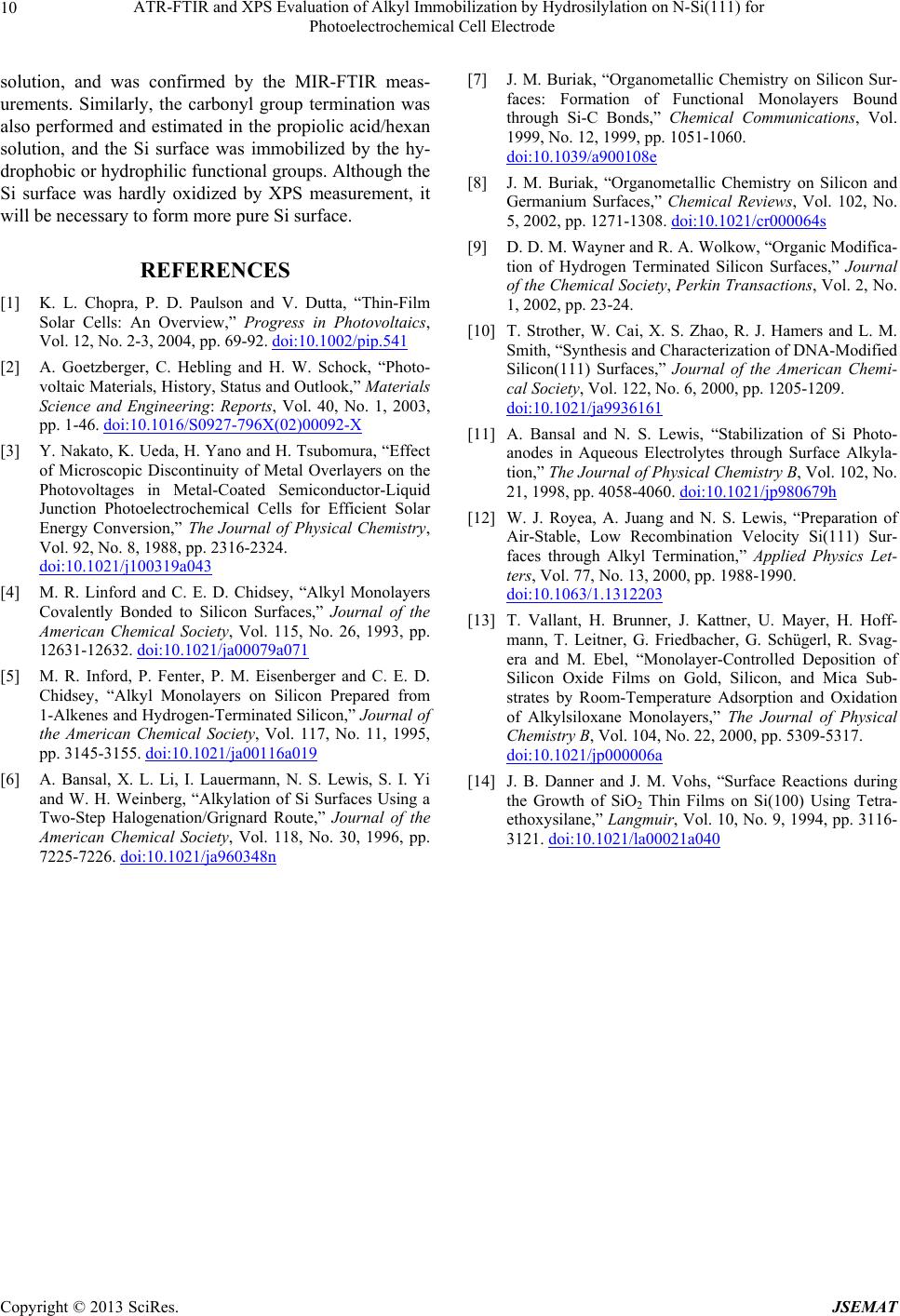
ATR-FTIR and XPS Evaluation of Alkyl Immobilization by Hydrosilylation on N-Si(111) for
Photoelectrochemical Cell Electrode
Copyright © 2013 SciRes. JSEMAT
10
solution, and was confirmed by the MIR-FTIR meas-
urements. Similarly, the carbonyl group termination was
also performed and estimated in the propiolic acid/hexan
solution, and the Si surface was immobilized by the hy-
drophobic or hydrophilic functional groups. Although the
Si surface was hardly oxidized by XPS measurement, it
will be necessary to form more pure Si surface.
REFERENCES
[1] K. L. Chopra, P. D. Paulson and V. Dutta, “Thin-Film
Solar Cells: An Overview,” Progress in Photovoltaics,
Vol. 12, No. 2-3, 2004, pp. 69-92. doi:10.1002/pip.541
[2] A. Goetzberger, C. Hebling and H. W. Schock, “Photo-
voltaic Materials, History, Status and Outlook,” Materials
Science and Engineering: Reports, Vol. 40, No. 1, 2003,
pp. 1-46. doi:10.1016/S0927-796X(02)00092-X
[3] Y. Nakato, K. Ueda, H. Yano and H. Tsubomura, “Effect
of Microscopic Discontinuity of Metal Overlayers on the
Photovoltages in Metal-Coated Semiconductor-Liquid
Junction Photoelectrochemical Cells for Efficient Solar
Energy Conversion,” The Journal of Physical Chemistry,
Vol. 92, No. 8, 1988, pp. 2316-2324.
doi:10.1021/j100319a043
[4] M. R. Linford and C. E. D. Chidsey, “Alkyl Monolayers
Covalently Bonded to Silicon Surfaces,” Journal of the
American Chemical Society, Vol. 115, No. 26, 1993, pp.
12631-12632. doi:10.1021/ja00079a071
[5] M. R. Inford, P. Fenter, P. M. Eisenberger and C. E. D.
Chidsey, “Alkyl Monolayers on Silicon Prepared from
1-Alkenes and Hydrogen-Terminated Silicon,” Journal of
the American Chemical Society, Vol. 117, No. 11, 1995,
pp. 3145-3155. doi:10.1021/ja00116a019
[6] A. Bansal, X. L. Li, I. Lauermann, N. S. Lewis, S. I. Yi
and W. H. Weinberg, “Alkylation of Si Surfaces Using a
Two-Step Halogenation/Grignard Route,” Journal of the
American Chemical Society, Vol. 118, No. 30, 1996, pp.
7225-7226. doi:10.1021/ja960348n
[7] J. M. Buriak, “Organometallic Chemistry on Silicon Sur-
faces: Formation of Functional Monolayers Bound
through Si-C Bonds,” Chemical Communications, Vol.
1999, No. 12, 1999, pp. 1051-1060.
doi:10.1039/a900108e
[8] J. M. Buriak, “Organometallic Chemistry on Silicon and
Germanium Surfaces,” Chemical Reviews, Vol. 102, No.
5, 2002, pp. 1271-1308. doi:10.1021/cr000064s
[9] D. D. M. Wayner and R. A. Wolkow, “Organic Modifica-
tion of Hydrogen Terminated Silicon Surfaces,” Journal
of the Chemical Society, Perkin Transactions, Vol. 2, No.
1, 2002, pp. 23-24.
[10] T. Strother, W. Cai, X. S. Zhao, R. J. Hamers and L. M.
Smith, “Synthesis and Characterization of DNA-Modified
Silicon(111) Surfaces,” Journal of the American Chemi-
cal Society, Vol. 122, No. 6, 2000, pp. 1205-1209.
doi:10.1021/ja9936161
[11] A. Bansal and N. S. Lewis, “Stabilization of Si Photo-
anodes in Aqueous Electrolytes through Surface Alkyla-
tion,” The Journal of Physical Chemistry B, Vol. 102, No.
21, 1998, pp. 4058-4060. doi:10.1021/jp980679h
[12] W. J. Royea, A. Juang and N. S. Lewis, “Preparation of
Air-Stable, Low Recombination Velocity Si(111) Sur-
faces through Alkyl Termination,” Applied Physics Let-
ters, Vol. 77, No. 13, 2000, pp. 1988-1990.
doi:10.1063/1.1312203
[13] T. Vallant, H. Brunner, J. Kattner, U. Mayer, H. Hoff-
mann, T. Leitner, G. Friedbacher, G. Schügerl, R. Svag-
era and M. Ebel, “Monolayer-Controlled Deposition of
Silicon Oxide Films on Gold, Silicon, and Mica Sub-
strates by Room-Temperature Adsorption and Oxidation
of Alkylsiloxane Monolayers,” The Journal of Physical
Chemistry B, Vol. 104, No. 22, 2000, pp. 5309-5317.
doi:10.1021/jp000006a
[14] J. B. Danner and J. M. Vohs, “Surface Reactions during
the Growth of SiO2 Thin Films on Si(100) Using Tetra-
ethoxysilane,” Langmuir, Vol. 10, No. 9, 1994, pp. 3116-
3121. doi:10.1021/la00021a040